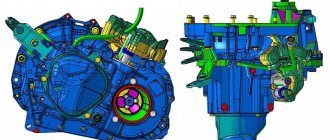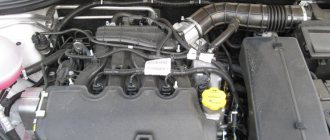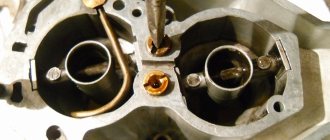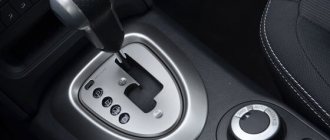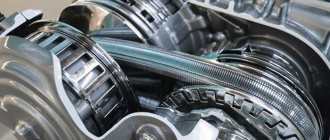CVT Rav 4 is a box with operating features. Reliability and service life depend on their compliance. Let's look at what a continuously variable transmission is, the main symptoms of malfunctions and the procedure for proper operation.
In Japan, continuously variable transmissions have been installed on Rav 4 since 2005 on engines with a volume of 2.0 and 2.4
Design and principle of operation
A variable speed transmission is the only type of drive that allows the ratio between the transmission and powertrain to be continuously varied.
The car picks up speed without increasing engine speed. The design of the variator for Toyota Rav 4 cars of 2010, 2011, 2013 and other years of production includes two sliding shafts. They interact with each other through a belt stretched between them. One of these pulleys is connected to the power unit and is considered the main one, and the second, driven, is connected to the drive wheels. Both pulleys consist of two halves. When these elements slide relative to each other, the belt is pushed outward, and when pulled back, it falls inward. As a result of a synchronous change in the radii of the parts along which the belt moves, the diameter of one shaft increases, and the diameter of the other decreases. This contributes to a smooth change in gear ratio. If the crankshaft size is smaller than the driven shaft size, the vehicle moves at a reduced speed. With the same pulley diameter, the car drives in direct gear. If the driven shaft size is smaller, the machine moves at a higher speed.
Toyota CVT
The Toyota Rav 4 2014, 2015, 2016, 2022 transmission uses a torque converter as a clutch. Its presence in the design allows for smooth starting and eliminates shocks during acceleration. Thanks to the use of a torque converter, the car shifts from a lower gear to a higher gear faster if the driver presses the accelerator pedal hard. To allow the car to roll backward, the transmission uses a planetary gear.
The operation of the drive transmission is controlled by a control system, which includes a central processor, a controller and a shaft control unit. The control module receives information about vehicle speed, power unit speed and accelerator pedal position. Based on this data, the central processor selects the gear ratio for a specific driving mode. If the rotation information of the primary and secondary pulleys does not match, the control module instructs the hydraulic system to change the size of the shafts. The operating pressure in the system is provided by a pumping device. This unit also lubricates the internal parts of the transmission.
The pressure parameter in the system is usually not determined by the speed of the power unit, but is maintained in proportion to the developing torque. As this indicator increases, the discs compress more, which prevents the strap from slipping. The amount of pressure created by the pumping device determines the speed of the variator gearbox. The larger this parameter, the faster the gear ratio will change. To lubricate internal parts and components, a special lubricant is used, intended for Toyota Rav 4 CVTs and produced by the car manufacturer.
Life time
Now let's see how long a continuously variable transmission goes on average. According to the owners, the unit is reliable and on average serves about 100-150 thousand kilometers without causing inconvenience to the motorist. Only after this time has elapsed are the first transmission errors possible.
Weaknesses, problems of variators
Problems may arise when operating the Toyota Rav 4 variator:
Belt and Cones - As the belt moves over the cones, especially during the initial movement, gradual wear occurs on the notches. They are located on the inside of the belt and serve as a working surface that provides the necessary grip on the cones. If the notches wear significantly, the vehicle's traction will decrease.
Stepper motor - used to change the gear ratio, works for no more than six years. If the stepper motor fails, the variator operates in single-gear mode.
Wear belt (https://www.transakpp.ru/uslugi/cvt-ill.html)
Bearings: Bearing failure is accompanied by increased vibration, extraneous noise and humming of the continuously variable transmission.
Pump and valve: malfunction occurs due to the use of low-quality or contaminated oil. First of all, wear of the valve is noted, which begins to jam, freeze, knock, and then the pump may fail.
Heat exchanger - over time, the cooling efficiency of the CVT oil has decreased. This is due to the gradual clogging of the heat exchanger, which also leads to a decrease in efficiency.
Signs of a CVT failure
imminent failure of the Rav 4 drive can be determined by the following signs:
Squeezing of the vehicle when starting or driving, even when the accelerator pedal is lightly depressed. This signal indicates a clogged oil pump valve.
The appearance of extraneous noise due to bearing failure. The decrease in their resource can be affected by:
- use of transmission oil that is unsuitable for its characteristics;
- constant overheating of the box;
- use of defective or low-quality bearings after repair;
- failure in electronics due to failure of any sensor;
- machine operation under high loads.
Variator belt (https://www.transakpp.ru/uslugi/cvt-ill.html)
What kind of CVTs are installed on Toyota RAV4
Toyota is unique in that it only installs Aisin boxes on its cars, including Lexus. It is an engineering company specializing in the production of transmissions for vehicles. A Japanese company that is dependent on, but not controlled by, Toyota. Only about 42% of Aisin's shares are owned by Toyota. In general, it is a fairly reliable and well-known manufacturer of gearboxes, one of the so-called “Big Three” - ZF, Borg-Warner, Aisin. Aisin transmissions can be found on many competing Toyota brands. The company decided to stimulate the supply of virtually its own gearboxes to other people's vehicles.
The Japanese manufacturer is known for its conservatism, so the company's management decided to buy a CVT from Jatco, modify it a little and adapt it to the technical characteristics of the RAV4. Many design parts, such as the belt or metal chain, are still interchangeable, meaning you can take these CVT replicas from one manufacturer and use them in a CVT from another manufacturer. The installation of a CVT on the Rav4 was done slowly and deliberately, first testing this functional change on other models. After successful tests on Verso, Avensis, Opa, it was decided to assemble a crossover with all-wheel drive and a two-liter gasoline engine.
CVT modification for Toyota RAV4 - Aisin K111 / K111F. The transmission has long been tested in cars intended for the domestic market. After just five years of operating vehicles with the Aisin K111/K111F, Toyota entered the international arena. All CVTs are divided into conditional groups, each group is focused on a specific torque. The K111 / K111F modification is part of the “hundredth” series, available for 2.0 and 2.4 liter engines. The only difference between K111 / K111F is that the F index indicates that it is intended for all-wheel drive vehicles.
Toyota Rav4 in everyday life
The enormous difference between the fourth generation and its predecessors is the dimensions and geometry of the interior. It’s not that it was cramped and tight before, but in this generation it has surpassed both itself and many competitors like the Ford Kuga. The rear sofa provides a generous amount of space for all three passengers, and the trunk (500+ liters), although it suffered from the transfer of the spare tire from the fifth door under the floor, still accepts long items and large cargo.
And all sorts of little things too. Following the example of older comrades like Audi, this Rav4 received a bunch of accessories for the trunk such as nets and guides/limiters. Everything works together to ensure that oversized items do not fly around the trunk from wall to wall, but are securely fixed.
In terms of options, the restyled versions are cooler and more packaged than the earlier copies. They have an advanced surround view system that draws a beautiful 3D projection of the car and surroundings, allowing you to see all the blind spots on the screen. They are, of course, poorly drawn, because the camera resolution is low, and it’s hardly worth pursuing such options.
Very late versions of Rav4 (after 2016) had a media system with Yandex services. The same “Maps” in this version are much more detailed and accurate than the standard navigation system, which migrated to the Rav4 from the early “zeros”.
Otherwise, the equipment of pre-restyling and restyled cars is no different. Both have climate control, a USB port with the function of recharging a connected gadget, and a simple on-board computer. So if the price gap between the options you like is large, you can safely take the older and cheaper one. You won't lose anything in terms of functionality.
The most common problems with Aisin K111/K111F
Now let’s find out what the resource of the Toyota Rav4 variator is. If you talk to the service people who service the Japanese car and its CVT on a daily basis, it's easy to see that the K111/K111F is not such a problem-free unit. In it, bearings are much less likely to be “cut” for no reason, as in the Nissan Qashqai, but these parts are subject to premature destruction. If extraneous noises still occur, it is better to immediately contact the nearest service station for diagnosis. An increase in noise during operation of a machine's transmission is also associated with premature wear of the metal belt, which is in contact with the cones and acts as the main part of the gearbox. It is important to warm up the transmission to avoid belt breakage, which will lead to costly repairs. Experts usually recommend changing it as a preventative measure every time the bearing is replaced.
As for noise, the reasons for its occurrence can be very different. In some cases, it is enough to replace the transmission fluid, but sometimes more serious specialist intervention is required. Due to used filters, the system may be contaminated with foreign particles - wear products of the mechanical parts of the gearbox. A manufacturing defect cannot be ruled out. Often bearings in one or another modification of the variator do not have sufficient load capacity and a high accuracy class. For these and many other reasons, incorrect operation of the transmission may occur. But cases of defects or other engineering miscalculations are rare. In most cases, CVT components wear out due to aggressive driving and improper maintenance.
The box should not overheat under any circumstances: rubber seals and gaskets are doubled. If malfunctions are often observed in the normal temperature regime of the variator, it is necessary to look for the cause in a dirty radiator. No CVT transmission is complete without its own cooling system. Parts and assembly mechanisms actively heat up even during measured and leisurely work, which leads to a reduction in their service life. The Aisin K111 / K111F radiator quickly becomes contaminated with midges, dirt, dust and other foreign particles that disrupt natural heat transfer. Therefore, it should be cleaned regularly to avoid wasting money on expensive repairs in the future.
Toyota Rav4: who is it for?
And why “he” and not “she”? Previous generations of "Rafik" had a reputation as a ladies' man, not least due to his pretty, round appearance and easy-going personality. By the fourth generation, a reassessment of values occurred.
Firstly, he became stronger, coarser, matured and sharpened; secondly, it has become more versatile as a car. And passengers of all ages, sizes and heights feel comfortable in it, they can carry loads, and they can enjoy driving. He steers, jokes, and in certain situations he even gets up sideways and drives, and boys already appreciate this.
So, if you were born a man and were previously ashamed to look towards the Rav4, now you don’t have to be ashamed. He is moderately brutal, can drive and is suitable for a family.
Reviews of the variator on the RAV4: advantages and disadvantages
The opinion of pilots who have encountered a CVT gearbox, as well as technical characteristics, are the main assistants in determining the possibility of purchasing a RAV4 in a CVT configuration. The main advantages of the solution are:
- Economical and safe: the engine constantly runs at the optimal speed without the need to shift up or down. This allows you to significantly reduce the amount of fuel consumed. Along with this, the level of harmful impurities in exhaust gases is also reduced.
- Silent movement: the special shape of the discs on the shafts completely solves the problem of car jerking when changing gear ratios. RAV 4 with a CVT gearbox accelerates and brakes smoothly, which does not cause discomfort.
- Low unit weight: The CVT is much lighter than automatic and manual cars, which means the vehicle weighs less. This indicator has a positive effect on dynamics and acceleration, and also reduces wear on parts and mechanisms involved in the operation of the internal combustion engine and transmission.
In addition to noticeable advantages, the unit also has a number of disadvantages. They appear, as a rule, at the beginning of the vehicle’s operation and remain throughout the entire life cycle of the box. The main disadvantages, regardless of generation, include:
- Extraneous noise - Regardless of engine speed, the CVT is really loud. At Toyota, the problem is partially solved by sound insulation, while many deliberately refuse factory protection, spending money on more productive solutions.
- Careful handling required: Driving with a CVT is somewhat different from what you normally do with a manual or automatic. Drivers must constantly comply with a set of rules, which served as the basis for many instructions from RAF 4 owners. Maintenance also has its own nuances.
- Price - CVT gearboxes are considered one of the least repairable. At gas stations, when breakdowns are detected, it is customary to use rather expensive repair kits that replace most of the broken boxes. In addition, it is not easy to buy a complete gearbox; you have to order them directly from the factory, which leads not only to costs, but also to long downtime for the car to be repaired.
The characteristics of the gearbox in question make a mixed impression. The CVT for the Toyota RAV4, according to the owners, is problematic, but convenient.
Anyone who decides to buy a car with this configuration must strictly follow the operating rules and carry out all maintenance on time. When considering the option of buying a used car, it is advisable to check whether the box has been replaced. They usually fail closer to 150 thousand km.
CVT repair
What problems are typical for a CVT and how to fix the box in a car with a 2-liter engine or another volume:
- Failure of the planetary unit. When the unit operates under conditions of high loads, this leads to the destruction of the gear axes, as a result of which their teeth break. In this case, the teeth must be replaced.
- Thirst for oil. Without lubrication and with the engine running at high speeds, when operating the vehicle off-road, the planetary gear fails. You can see such a malfunction when replacing the filter device. Magnets installed in the pan collect wear products in the form of metal shavings; they need to be inspected. If the car's mileage is more than 150 thousand km and the size of the steel shavings is more than 1 mm, this indicates that during operation of the unit a chain reaction of gear destruction occurs. If a planetary gearbox is left unattended, it may damage the pumping unit and other gearbox components. In this case, repairs will be expensive.
- Front gearbox malfunction. When operating a car in aggressive conditions, this part is damaged. The wear products of the element damage the crown over time. If the problem is not corrected in time, the presence of metal shavings can damage the rear planetary gearbox assembly. As a result, the clutches will fail.
- During intensive use, especially in off-road conditions, rapid wear of the bearing support devices occurs. These are parts located on the input and output shafts. Solving this problem is quite difficult, since you will not find Toyota variator bearings on sale. CVT parts are not supplied to the aftermarket. Therefore, to solve the problem, you will have to look for bearings using automatic disassembly or buy similar ones in size and grind them on a lathe to the size of the parts being installed. This repair option is considered the cheapest.
- Broken sensors. CVT transmissions are equipped with a large number of different electronic controllers designed to read data and transmit it to the control unit. Sensor failure can affect the operation of the variator as a whole. If the diagnostics showed a controller failure, you need to check it in detail. It is necessary to check the connectors and contacts. Often the cause of malfunction lies in a damaged plug.
- Malfunctions in the control system. If the CPU fails, the transmission will not work. If the control module goes out but is still running, the transmission will operate but will be rough. It is better to entrust the solution to the problem in the operation of the control unit to professionals. Sometimes you need a flashing unit, but it is almost impossible to do this at home.
- Broken drive belt. Due to rapid wear, the drive belt may break if used incorrectly. Its connections can become lost in the transmission and damage other drive components.
Damage to the differential flange is especially dangerous. The so-called transfer case drive passes through a flange on the differential housing. This element has thin walls, and in practice problems often arise when the part bursts due to operation under constant high loads. This causes lubricant leakage. If not detected and corrected promptly, the transmission fluid may completely leak from the transmission. Additionally, the flange will collapse in the system and pieces will fall onto the transmission gears, damaging transmission components. The difficulty of repair is that differentials for CVT transmissions are not commercially available.
The car owner has the opportunity to purchase a new assembly unit, which will cost more than $15,000. The problem can be solved by installing a contract drive, but finding such a unit on sale is also problematic. In addition, the cost of such a unit will be quite high. The problem can be optimally solved in the phase of oil leaks and cracks. In this case, press any suitable compression sleeve onto the damaged flange and remove all traces of leaks. But please note that it is impossible to give exact guarantees regarding the validity period of this solution. Usually, after such manipulations, car owners try to sell the vehicle as quickly as possible.
Rules of operation and maintenance
What nuances should be taken into account in order not to reduce the resource of the Toyota Rav 4 variator:
- Do not start moving from a standstill by pressing the gas pedal all the way. The structural elements of the gearbox are subject to high loads, which will lead to damage to parts.
- Do not tow other vehicles. Towing trailers is also not recommended. CVT gearboxes are designed to work with a certain vehicle weight and cannot be increased.
- Reverse gear cannot be engaged or disengaged until the car has come to a complete stop.
- Try to drive less at top speed. This may cause the engine speed to fluctuate.
- Avoid wheel slip. Cars often slip when they get stuck in mud or snowdrifts. You should not try to drive out of an obstacle while rocking, alternately turning on modes R and D. This will lead to a decrease in the service life of the CVT transmission. It is better to put the car in neutral and ask someone to pull the car out of the obstacle.
- When the emergency mode is turned on, the car owner needs to turn off the power unit of the car and try to start it again. If the box works normally after restarting the engine, you can continue to use it. If the emergency mode remains, then diagnostics of the unit is required, and it is advisable to perform it as quickly as possible.
- During the cold season, always warm up the transmission. The car engine heats up faster than the transmission, so when the engine warms up, you cannot assume that the transmission has also warmed up. At low negative temperatures, it will take at least 10 minutes to fully warm up the unit. Only after this is it possible to drive at normal speed. To warm up the transmission faster, you can turn on all modes on the gearbox selector one by one, staying in each of them for a few seconds. This will allow the oil to circulate faster through the channels of the transmission system.
- During the operation of the vehicle, we must not forget about the need to regularly check the oil level. If diagnostics show that the lubricant in the system is less than normal, you need to check the condition of the gearbox. The cause may be a fluid leak. If wear debris is visible in the oil, and there is also a burning smell coming from it, the lubricant must be replaced. Please review the service book before performing this task. According to the regulations, the manufacturer prohibits the use of any oil other than Toyota Genuine CVT Fluid TC or Toyota Genuine CVT Fluid FE in transmissions. The use of consumables from other manufacturers may cause problems with the transmission. You may feel vibrations in the area of the gear selector, and the lever itself may jam. In some cases, complete failure of the unit is possible if the quality of the lubricant does not meet the standard.
- You cannot turn on the neutral gear mode at every short stop, in a traffic jam, at traffic lights, etc. If you know that you will be standing for a long time, turn on the parking sensors mode. Neutral speed is considered an emergency speed. It can be turned on if the car needs to be pulled out of a snowdrift.
- Avoid off-road driving. Toyota RAV4 belongs to the class of crossovers, but the CVT transmission installed on these cars is not intended for regular operation on bad roads or rural areas.
The Automatic Transmission Technology channel provided a video, the author of which talked about what nuances to take into account during operation in order to increase the service life of the CVT gearbox.
Which is better: automatic or variator
A clear answer to this question can be given through independent testing of models with different gearboxes. Automatic transmissions are characterized by high strength, reliability and good maintainability. With proper maintenance, cars can travel at least 300,000 km.
However, on the opponent’s side is comfort due to the absence of shocks and lower fuel consumption.
Shock is an increase in noise, the elimination of which requires additional costs for the owner. The variator on the Toyota RAV 4 significantly loses its service life - problems can be found after 100 thousand km.
Video “How to change the oil in a Rav 4 CVT transmission?”
User Andrey Florida in his video explained in detail and showed how to change the lubricant in the CVT gearbox of a Toyota Rav 4.
Do you have any questions? Specialists and readers of the AUTODVIG website will help you ask a question
Was this article helpful?
Thank you for your opinion!
The article was useful. Please share the information with your friends.
Yes (95.45%)
No (4.55%)
X
Please write what is wrong and leave recommendations on the article
Cancel reply
Rate this article: ( 91 votes, average: 4.87 out of 5)
Discuss the article:
How to drive a CVT correctly to last longer
Not long ago, domestic motorists learned how to properly drive a RAV 4 with a CVT. And many have already gotten used to the fact that there is no third pedal. However, don't equate an automatic transmission with a continuously variable transmission.
Don't overload it. Toyota RAV-4, equipped with a CVT, is “afraid” of floating loads. In addition, it is necessary to warm up the engine in cold weather. This is necessary to distribute the oil throughout the system (cold lubricant does not completely cover all parts). It is not recommended to change modes (“PRND”) to improve heating, as this is useless. It should be remembered that the design of the variator differs from other gearboxes. You can temporarily activate the “N” (neutral) mode to warm up the hydraulic coupling (clutch).
Do not drive until the engine is properly warmed up. To fully warm up the entire box, drive at least a kilometer at a calm pace. In addition, the heating time directly depends on the air temperature (the colder it is, the longer the waiting time). It is not recommended to use a car if the thermometer is -35 ° C. But if there is an urgent need for a trip, heating should be on for at least half an hour, after which you cannot use an aggressive driving mode while traveling. By spending more gasoline, you save on replacing the Toyota RAV-4-2.0 variator.”
The SUV does not steer. If the vehicle is equipped with a CVT transmission, driving it off-road is not recommended. SUVs with a CVT, despite the advertising of manufacturers, are still classified as “SUVs”.
If you hit an obstacle, there is a risk of damage to the continuously variable transmission.
No trailer. Towing and skidding are equally dangerous for the CVT. Before you start towing a Toyota-RAV-4, read the instructions. The engine must be running to protect the elements from friction. However, this is not always insurance against breakdown and subsequent replacement of the variator. Therefore, we do not recommend towing, especially for used transmissions.
How long does a CVT run on a Toyota Rav 4?
The service life of the variator depends on several important factors, which include both the conditions of use of the car by the owner and the operating rules prescribed by the manufacturer. These terms include.
- No long-term constant high loads on the transmission when driving on country roads. The most common load is long-term driving at high speeds of more than 140-150 km/h.
- No slipping when driving on snow and ice. Although the Rav 4 has an all-wheel drive system, in fact, this model is not a full-fledged SUV; its off-road capabilities are limited. With frequent, constant slipping, the drive is susceptible to overheating, which can lead to mechanical deformation and, as a result, failure.
- Avoid transporting goods using a trailer or other vehicles with a rope. The electronic transmission control unit is designed for certain loads depending on the weight of the vehicle itself. A prolonged increase in this load leads to malfunctions not only of the electronic control, but also reduces the resources and reliability of the unit as a whole.
- Timely replacement of transmission fluid depending on weather, temperature and other vehicle operating conditions. The manufacturer prescribes such a replacement every 130 thousand kilometers, but in practice, experienced owners carry out this procedure at least twice as often. Timely fluid replacement increases the specified life of the unit.
In general, compared to other CVTs from other manufacturers, this model copes well with its tasks and, with careful operation, can not only “take away” the allocated resource, but also significantly exceed it. There are known cases of mileage of 300 thousand kilometers without repair in this system, which indicates the good reliability of the Toyota Rav 4 variator.
What is a variable speed drive (CVT)?
Direct Shift-CVT
The CVT is a continuously variable transmission type. Another name for the device is the English abbreviation CVT (Continuously Variable Transmission) , which translates as constantly changing transmission . In the operation of the mechanism, a change in gears is observed that differs from the traditional scheme, which involves sequential gear shifting.
The operation of the variator is controlled by electronics, which is responsible for transmitting traction in automatic mode. Which allows us to classify CVT as an automatic transmission, but there are differences. Among them:
- Smaller dimensions and weight.
- The ideal ratio of the gear ratio, which shows the ratio of the speed of rotation of the crankshaft and wheels, with the current load on the power unit.
- Transmission design close to ideal.
Despite the listed qualities of the Rav 4 with a variator, you should carefully study all the nuances in order to make a final conclusion about the reliability and service life of the mechanism.
Advantages and disadvantages
The advantages of the Toyota Rav 4 variator include:
- acceleration dynamics relative to automatic transmission;
- lower fuel consumption;
- smooth change of gear ratio;
- increased efficiency (5-10%) compared to automatic transmission.
There are also disadvantages:
- complex and expensive repairs;
- maintenance: frequent oil changes (30,000 km);
- complex circuit of the electronic control unit.
Rav 4 3 after restyling in 2010, then the 4-automatic transmission was replaced by a CVT
Advantages and disadvantages
To understand which is better - a CVT or an automatic, you need to understand the pros and cons of CVT transmissions.
Advantages:
- Lower fuel consumption than automatic transmissions. Due to the lack of efficient gear shifting and constant operation at the optimum speed, CVT engines operate more economically. In addition, the volume of harmful substances released into the atmosphere through exhaust gases is reduced.
- Smooth gear changes while driving. This ensures that there is no bumping or jolting as the vehicle speed increases. For this reason, the service life of individual gearboxes is also increased.
- Reliability of the unit.
- Good car dynamics.
- Reduced gearbox weight.
Flaws:
- Noisy. The effect of the variator can be compared to the noise of a trolleybus while driving.
- Transmission sensitivity. When using vehicles with CVT transmissions, you must strictly adhere to the operating and maintenance rules. Otherwise, this may damage the structural components of the gearbox and affect its service life.
- Expensive and difficult to repair. If the structural elements of the gearbox fail, finding new parts is problematic. They are not always available for sale.
Faces of Toyota Rav4 (CA40)
The IV generation Rav4 debuted on the Russian market at the beginning of 2013, and was restyled in 2016. And this was precisely restyling, not modernization. Body panels, optics, and some interior details have changed. Technically, the entire life cycle of the Rav4 went through the same set of units.
SA40 also changed its registration. Pre-styling versions came to Russia from abroad. After the upgrade, full-scale assembly, along with welding and painting of the body, began to be carried out in St. Petersburg.
There was no drop in quality or popular love due to the move. The buyer did not seem to notice the change of factory, so imported and localized copies cost approximately the same on the secondary market.
CVT failures on Rav 4
Despite its simple design, the variator often fails. This is due to the fact that the car owner simply does not take care of the car and the gearbox. The variator does not like:
- dirty oil. Waste grease no longer protects the side panels. As a result, scratches are formed that have a bad effect on the belt and lead to rapid wear of the box;
- a dirty filter reduces the flow rate. As a result, the pressure decreases. And this leads to the fact that trees begin to fail. The belt begins to slip or slip. Torn and scattered all over the box. In the case of a metal chain, major repairs are guaranteed, as this will damage all parts of the box.
Attention! The CVTK111 features some brakes, unlike Japanese company Jatko's changes to Nissan. This is because manufacturers have reduced the acceleration rate to ensure that the belt and pulleys remain intact and intact for their entire service life.
Other problems with the box:
- failure of the electronic control unit due to water getting inside due to improper washing of the car;
- destruction of pulleys and belt due to overheating.
And also some others that arise solely through the fault of the car owner. Since these cars are suitable for both city driving and light off-road driving. They don't like dirt roads, snow-covered paths where you have to slide to get out. As a result, they overheat and quickly fail.
Experts do not advise taking high speed on the highway and driving for twenty minutes. This will lead to overheating and abrasion of the crankshaft.
Sources
- https://autodvig.com/kpp/resurs-variatora-tojota-rav-4-27639/
- https://toyota-navi.ru/toyota/opisanie-variatora-na-toyota-rav4-resurs-ustrojstvo-i-ekspluatatsiya-korobki.html
- https://Autoprokat-RentMotors.ru/korobka-peredach/variator-rav-4-resurs.html
- https://igor-somov.ru/otzyvy/variator-rav4.html
- https://7road.ru/remont-i-tyuning/variator-rav-4-2017-otzyvy.html
- https://auto-kontent.ru/resurs-variatora-toyota-rav4-2-0/
- https://max-lada.ru/toyota/opisanie-variatora-na-toyota-rav4-resurs-ustrojstvo-i-ekspluatatsiya-korobki.html
- https://4-x-4.ru/variator-na-rav-4-otzyvy/
- https://kvadrocikly-stels.ru/inostrannye-avto/variator-na-rav-4-otzyvy.html
- https://www.zr.ru/content/articles/922601-poderzhannaya-toyota-rav4/
- https://toyota-camry-corolla.ru/rav-4/izuchaem-variator-rav-4/
- https://gil-service.ru/obzor/variator-rav4.html
- https://razborov.net/toyota/opisanie-variatora-na-toyota-rav4-resurs-ustroystvo-i-ekspluataciya-korobki-2.html
- https://Avto-remont-Toyota.ru/cvt-toyota-rav-4-osobennosti-bolezni-i-otzyvy-vladelcev.html
What the variator doesn’t like
The CVT really requires a more careful attitude - this is a price to pay for comfort. A continuously variable transmission can live a long and happy life if you properly care for it, maintain a calm driving style and do not violate the manufacturer’s requirements.
Conversely, the following typical driver mistakes lead to premature transmission failure. What can't you do with a variator?
A sharp start from a standstill
The CVT is designed primarily for a comfortable, smooth ride. He does not like sudden jumps in engine speed, as they lead to slippage of the belt (chain) on the pulleys. As a result, burrs and chips are formed, which act as an abrasive on the internal parts of the assembly. This provokes their untimely wear.
Therefore, in a car with a CVT, it is not recommended to “rush away”, trying to get ahead of everyone at a traffic light. This threatens to compromise the health of the transmission.
By the way, about virtual gear shifting, which many continuously variable transmissions offer to simulate the usual rhythm. Despite the fact that this mode is provided in cars with a CVT, we don’t use it too often.
“Gears” do exist in modern manual CVTs, although they are implemented differently than in other types of gearboxes. The concept of one gear or another in a classic transmission implies a fixed ratio of two gears of different diameters, which are currently in rigid mesh. The design of the variator, by definition, assumes a smooth and continuous change in this value during movement. But to make it more familiar to the driver, if he suddenly wants to “steer” the gearbox on his own, the electronics will emulate those same 5-6 (or more) speeds. When you select each of them manually, the variator belt (chain) will be in a certain fixed position, maintaining a constant gear ratio between the pulleys. However, frequent use of this mode will not benefit the unit, as it is fraught with the formation of grooves on the pulleys.
Driving at high speeds
The CVT is afraid not only of sudden starts, but also of prolonged accelerations. Long-term driving at high speed leads to overheating of the mechanical parts of the transmission - and, as a result, to their rapid wear.
The more often you “drive” from traffic lights, the faster you will go to repair the gearbox.
Start with two pedals
Owners of cars with automatic transmissions skillfully use the technique of simultaneously pressing two pedals for quick start and acceleration. This allows them to quickly accelerate from a traffic light, leaving other road users behind.
But the variator is not designed for such a “trick” - with the help of two pedals you can only achieve a reduction in the life of the torque converter, the repair of which costs a pretty penny.
If you switch to a car with a CVT, forget your old “habits”.
Getting started without pre-warming
The debate about whether to warm up your car before driving is almost as old as the chicken and the egg debate. Manufacturers do not have strict mandatory recommendations, and in concern for the environment, heating is now viewed rather negatively. However, it is better to warm up a car with a continuously variable transmission before driving, despite the unkind glances of passers-by. The variator reacts negatively to sudden temperature changes, this leads to the same slipping of the belt on the pulleys.
You should start driving only after the oil in the box has warmed up to operating temperature. This is especially true for the cold season.
Frequent slipping
By competently driving a car with a CVT, you can effortlessly overcome obstacles in the form of sand and snow. This is facilitated by the smooth operation of the transmission. But slipping is dangerous for her. Therefore, it is better to avoid dangerous areas in the form of mud and snow. Otherwise, shock loads on the box, belt slippage and overheating cannot be avoided.
Slipping is especially not recommended in winter, in conditions of low air temperature.
Towing other vehicles
Long-term increased loads can easily “kill” the variator right on the road. Therefore, it is not recommended to use a car with a continuously variable transmission as a “tug”. Slow movement under pressure, under load, and especially uphill, is just as harmful as sudden acceleration and racing at high speeds.
It is strictly forbidden to use a car with a CVT as a “tractor” when trying to rescue another vehicle from mud or snow.
Off-road driving
The continuously variable transmission is designed primarily for the city and high-quality country roads. However, a crossover with a CVT can be used off-road - but within reasonable limits. After all, the variator values moderation most of all, but increased loads and impacts can play a cruel joke on it.
Expert clarification:
The bottom line is that with a critical increase in the temperature of the transmission fluid, the friction properties of the belt (chain) sharply decrease - it simply begins to slip. Thereby cutting grooves on the pulleys and causing their rapid and severe wear. We have already mentioned this effect above in the description of the operation of the variator “gears”. Only in the case of active attack on mud, sand or snow areas does the destructive effect occur much faster and more sharply. Modern electronic off-road assistants also make a significant contribution. We are talking, first of all, about electronic imitations of blocking. With sharp and frequent braking of a slipping wheel, shocks in the transmission inevitably reach the same notorious pulleys - causing microslips between them and the belt. The consequences are predictable: production on the surface.
Conclusion: driving a car with a CVT off-road requires maximum care.
However, technology does not stand still, and this recommendation no longer sounds so clear. At least for certain models. Toyota's new CVTs have a gear-type mechanical first gear that operates at low speeds. This means that the continuously variable transmission does not participate in the swing and does not suffer, the loads are removed from the belt when driving off-road under tension.
Driving on curbs
Even a small curb poses a danger to the vehicle's suspension and transmission, especially when it comes to a CVT. If from time to time you encounter an obstacle with your front wheels, expect the gearbox to fail soon. And if the impact is strong enough, the gearbox can go into emergency mode, and then the pulleys will take an intermediate position, at which the belt will experience a critical load.
Running over a curb is unsafe for a car with a CVT.
Frequent switching back and forth
CVT generally does not like sudden movements, including abrupt switching between modes. Many drivers do not know about this and, in a car with a CVT, use the traditional method of “swinging” back and forth (when you need to get out of a snow hole or sand drift). Not counting CVTs with mechanical first gear. However, the shorter the pause between switchings, the faster the box fails.
When parking, back and forth, you need to wait until the car comes to a complete stop each time.
Abrupt switching between modes N and D
When the driver moves the lever to the neutral position (N), the pressure level inside the box drops. It takes a few seconds for it to recover. Otherwise, the friction clutches fall off and the belt suffers, which directly affects the service life of the gearbox.
Having turned on neutral while standing in a traffic jam, you should not sharply accelerate, following the car in front - it is better to take care of the transmission.
Coasting in neutral mode
Another mistake is to turn on the neutral mode when the car is coasting, without engine input. By doing this, drivers try to “free” the wheels from the coupling with the engine. Which makes sense in the case of a manual transmission or automatic transmission, but is completely meaningless in the case of a CVT.
Once again disconnecting the continuously variable transmission and the engine while driving, you bring the need for CVT repair closer.
Stopping without turning on N or P mode
But when you really need to turn on neutral (N) or park mode (P) - it’s when you stop, even for a short time. If the car has completely stopped, it would be a good idea to remove the mechanical stress from the torque converter. This will extend the life of the gearbox.
Even during a short stop, say, in traffic jams, switch to neutral, and for a longer one, activate the parking mode.
11. Late oil change
The oil in the gearbox needs to be changed periodically. During operation, it is produced, losing its properties, causing overheating and increased friction of parts of the structure. Small chips act as an abrasive and accelerate wear of parts.
Change the oil without waiting for the period recommended by the manufacturer (its recommendation is very conditional). It is better to do this every 30-40 thousand km.
No periodic cleaning
Gearbox maintenance is not limited to just changing the oil. You need to clean the pan, magnets and hydraulic system valves, and don’t forget to change the filters. If you do not do this, abrasive particles will continue to accumulate and increase their negative impact on the internal parts of the structure.
It is convenient to carry out cleaning every time you change the oil and related consumables.
Incorrect evacuation
Inexperienced owners of cars with a CVT often make a fatal mistake - they tow the car with the engine turned off. In this case, the rotation of the wheels drives one shaft, and the belt (or chain) “undermines” the other. The result is premature transmission repair.
A car with a CVT can only be towed with the engine running. And evacuation is allowed only if the drive wheels are loaded onto the platform.

